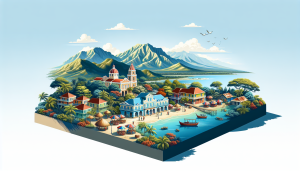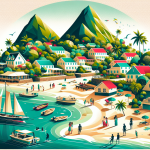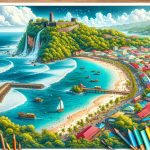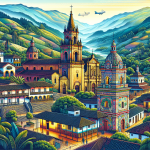Exploring Haiti: A Caribbean Gem Waiting to be Discovered
Haiti, a mesmerizing country in the Caribbean, often overlooked, holds a treasure trove of cultural, natural, and historical wonders. From its stunning beaches and vibrant art scene to its rich history and resilient spirit, Haiti offers a unique travel experience that beckons adventurous souls. This article delves deep into the multifaceted beauty of Haiti, shedding light on its diverse attractions, vibrant cities, and hidden gems. Whether you’re a history buff, nature enthusiast, or cultural connoisseur, Haiti promises an unforgettable journey. So pack your bags and get ready to explore Haiti, the Caribbean’s best-kept secret.
The Rich History of Haiti
Haiti’s history is as rich and complex as its landscape. It was the first country in the world to abolish slavery and gain independence from colonial rule, setting a powerful example for other nations.
The Birthplace of Haitian Independence
In 1804, Haiti became the first independent black republic, following a successful slave revolt against French colonial rule. This monumental event not only shaped the nation’s identity but also left an indelible mark on global history. The Citadelle Laferrière is a testament to this era, standing proudly as the largest fortress in the Americas. A visit to this historic site offers a glimpse into Haiti’s revolutionary past and the indomitable spirit of its people.
Cultural Heritage Sites
Haiti boasts several UNESCO World Heritage Sites that reflect its rich cultural history. The Sans-Souci Palace, often dubbed the “Versailles of the Caribbean,” was the royal residence of King Henri I. Despite being partially destroyed by an earthquake, its ruins still evoke a sense of grandeur and historical significance. Another must-visit is the Ramiers, a series of fortifications that played a crucial role in the country’s fight for freedom.
Natural Wonders of Haiti
Haiti’s natural beauty is nothing short of breathtaking. From majestic mountains to pristine beaches, the country’s diverse landscapes offer a plethora of outdoor activities and scenic vistas.
Beaches and Coastal Attractions
Haiti’s coastline is dotted with stunning beaches that rival those of its more famous Caribbean neighbors. Labadee is a private beach resort that offers a slice of paradise with its crystal-clear waters and white sandy beaches. Jacmel Beach is another gem, known for its vibrant local culture and artistic community. Here, visitors can relax on the beach, explore local art galleries, or participate in the annual Jacmel Carnival, a colorful celebration of Haitian culture.
Mountains and Hiking Trails
For those who prefer mountainous terrain, Haiti does not disappoint. The Massif de la Selle and Massif du Nord mountain ranges offer numerous hiking trails that lead to breathtaking viewpoints. Pic la Selle, the highest peak in Haiti, provides a challenging yet rewarding trek. The journey to the summit is an adventure filled with lush forests, rare wildlife, and panoramic views of the surrounding landscape.
Waterfalls and Natural Springs
Haiti is home to several stunning waterfalls and natural springs that offer refreshing escapes from the tropical heat. Bassin Bleu in Jacmel is a series of turquoise pools and cascading waterfalls that provide a serene setting for swimming and relaxation. Saut-d’Eau, another popular waterfall, is not only a natural wonder but also a site of religious significance, attracting pilgrims during the annual Sainte Anne Festival.
Vibrant Cities and Towns
Haiti’s cities and towns are vibrant hubs of culture, history, and daily life. Each offers a unique glimpse into the country’s diverse character and charm.
Port-au-Prince: The Heart of Haiti
As the capital city, Port-au-Prince is the bustling heart of Haiti. It’s a city where history and modernity coexist, offering a myriad of attractions for visitors. The Iron Market is a must-visit, where you can find everything from local crafts and spices to voodoo artifacts. The Musée du Panthéon National Haïtien (MUPANAH) provides a comprehensive overview of Haiti’s history, from its indigenous roots to its revolutionary triumphs.
Jacmel: The Artistic Soul
Jacmel is often considered the artistic soul of Haiti. This coastal town is renowned for its vibrant arts scene, colonial architecture, and lively festivals. The Jacmel Arts Center is a hub for local artists, offering workshops, exhibitions, and performances. The town’s annual Film Festival attracts filmmakers and cinephiles from around the world, showcasing the best of Haitian and international cinema.
Cap-Haïtien: Historical and Cultural Hub
Cap-Haïtien, located in the northern part of the country, is rich in historical and cultural significance. It was once the capital of the French colony of Saint-Domingue and played a pivotal role in Haiti’s fight for independence. The city is a gateway to several important historical sites, including the Citadelle Laferrière and the Sans-Souci Palace. Cap-Haïtien’s vibrant markets, colonial architecture, and lively music scene make it a must-visit destination for history buffs and culture enthusiasts alike.
Unique Cultural Experiences
Haiti’s culture is a vibrant tapestry woven from its African, French, and indigenous roots. The country’s traditions, music, and art reflect its rich heritage and resilient spirit.
Music and Dance
Music and dance are integral parts of Haitian culture. The country’s traditional music, known as Kompa, is a lively blend of African rhythms and European melodies. Rara is another popular genre, characterized by its festive, carnival-like atmosphere. Visitors can experience these musical traditions firsthand at local festivals, nightclubs, and street performances.
Haitian Art
Haitian art is renowned for its vibrant colors, intricate designs, and powerful symbolism. The country’s artists draw inspiration from their cultural heritage, religious beliefs, and daily life. The Iron Market in Port-au-Prince and the art galleries in Jacmel are excellent places to discover and purchase Haitian art. The Grand Rue Artists are a collective of local artists known for their imaginative sculptures made from recycled materials.
Voodoo: A Misunderstood Tradition
Voodoo is an essential aspect of Haitian culture, often misunderstood and misrepresented. It’s a spiritual practice that blends elements of African religions, Catholicism, and indigenous beliefs. Visitors can learn about Voodoo’s true nature and significance by attending ceremonies and visiting Voodoo temples. The Saut-d’Eau pilgrimage is an excellent opportunity to witness this spiritual tradition in action.
Culinary Delights of Haiti
Haitian cuisine is a tantalizing fusion of flavors, influenced by African, French, and Caribbean culinary traditions. The country’s food scene offers a delicious array of dishes that reflect its rich cultural heritage.
Traditional Haitian Dishes
Some must-try traditional dishes include Griot (fried pork), Tassot (fried beef), and Poulet Aux Noix (chicken with cashew nuts). Diri Ak Djon Djon (black mushroom rice) is a unique and flavorful rice dish made with a type of mushroom that gives it a distinctive black color. Soup Joumou, a pumpkin soup, is traditionally served on New Year’s Day to celebrate Haiti’s independence.
Street Food and Local Markets
Haiti’s street food scene is vibrant and diverse, offering a wide range of delicious and affordable options. Pâté, a flaky pastry filled with meat or fish, is a popular snack. Accra, deep-fried malanga fritters, are another favorite. Local markets, such as the Iron Market in Port-au-Prince, are excellent places to sample street food and experience the hustle and bustle of daily life.
Unique Beverages
Haiti’s beverages are as diverse and flavorful as its food. Rhum Barbancourt, a locally produced rum, is a must-try for spirits enthusiasts. Prestige is the country’s most popular beer, known for its crisp and refreshing taste. Akasan is a traditional cornmeal-based drink, often flavored with spices and sweetened with sugar.
Practical Travel Tips for Haiti
Traveling to Haiti requires some preparation and awareness to ensure a safe and enjoyable trip. Here are some practical tips to help you plan your journey.
Safety and Health
While Haiti has a reputation for political instability and natural disasters, it is generally safe for tourists who take the necessary precautions. Travelers should stay informed about the current situation, avoid areas with high crime rates, and follow local advice. It’s also essential to have travel insurance that covers medical expenses and emergencies.
Visas and Entry Requirements
Most visitors to Haiti will need a visa, which can be obtained from a Haitian consulate or embassy. Some nationalities are exempt from visa requirements for short stays. Travelers should check the latest entry requirements before their trip.
Currency and Payments
The official currency of Haiti is the Haitian Gourde (HTG), but US dollars are widely accepted. ATMs are available in major cities, but it’s advisable to carry cash, especially when traveling to remote areas. Credit cards are accepted in some establishments, but not everywhere.
Language and Communication
Haitian Creole and French are the official languages of Haiti. While English is spoken in some tourist areas, it’s helpful to learn a few basic phrases in Creole or French. This can enhance your travel experience and help you connect with the local people.
Transportation
Transportation options in Haiti include taxis, buses, and car rentals. Taxis are available in major cities, but it’s essential to negotiate the fare before the journey. Buses, known as “tap-taps,” are colorful and affordable but can be crowded and uncomfortable. Renting a car is an option for those who prefer more flexibility, but it’s advisable to hire a local driver familiar with the roads and traffic conditions.
Conclusion
Haiti, with its rich history, stunning natural beauty, vibrant culture, and resilient spirit, is a destination that offers a unique and rewarding travel experience. From the historic sites of Cap-Haïtien and the artistic soul of Jacmel to the bustling heart of Port-au-Prince, Haiti’s cities and towns are a testament to its diverse character and charm. The country’s natural wonders, including its pristine beaches, majestic mountains, and refreshing waterfalls, provide endless opportunities for adventure and relaxation. Haiti’s cultural traditions, music, art, and cuisine reflect its rich heritage and offer visitors a taste of its unique identity. While traveling to Haiti requires some preparation and awareness, those who venture to this Caribbean gem will be rewarded with unforgettable memories and experiences. So, explore Haiti and discover the hidden treasures of this remarkable country.








